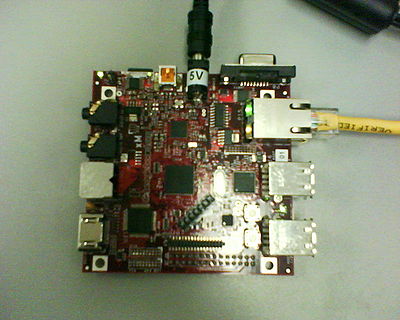Supporting Architectures above armv5tel
Contents
Project Name
Supporting Architectures Above armv5tel
Project Description
The armv5tel architecture version is supported by some common devices such as the Marvell Feroceon processors used in most plug computers. However, later versions of the architecture support advanced features, and using armv5tel code on those processors may result in suboptimal performance.
This project will research ways that Fedora-ARM could support higher processor versions effectively without recompiling the entire Fedora package universe -- for example, by providing an armv7 + hardfp glibc and kernel. This involves performance testing across multiple devices.
Initial contacts: ctyler, PaulW
Project Leader(s)
Project Contributor(s)
IRC:
#ubuntu-arm (persia)
#gentoo-embedded (solar and steev_)
Project Details
What the project is all about
Currently, Fedora only supports armv5tel hardware. With the introduction of armv7 architecture, Fedora-ARM is planning to upgrade its Fedora Universe. While it seems logical, re-compiling the whole Fedora package is a strenuous task; therefore before deciding to recompile, Fedora-ARM needs to make sure if the technologies provided by armv7 architecture proves significant performance difference against the currently used armv5tel architecture.
This project aims for that sole purpose. By running a benchmark and compiler optimizations, Fedora-ARM can contrast both technologies and use the results to decide if it's really worth to recompile the whole Fedora Universe to use armv7 architecture.
Below is a list of technologies by armv7.
ARMv7 Technologies:
There are currently 2 ARMv7 (beagleboard & beagleboard XM) builders in the Fedora ARM farm. These builders are running builds on ARMv5tel. This project will focus in using the beagleboardXM builder cdot-beagleXM-0-3
Specifications for the cdot-beagleboardXM-0-3 builder
beagleboardXM specific
beagleboardXM hardware page
cat /proc/version
Linux version 2.6.32 (ubuntu@ip-10-204-115-71) (gcc version 4.3.3 (GCC) ) #3 PREEMPT Wed Aug 18 15:53:03 UTC 2010
cat /proc/cpuinfo
Processor : ARMv7 Processor rev 2 (v7l)
BogoMIPS : 515.72
Features : swp half thumb fastmult vfp edsp thumbee neon vfpv3
CPU implementer : 0x41
CPU architecture: 7
CPU variant : 0x3
CPU part : 0xc08
CPU revision : 2
Hardware : OMAP3 Beagle Board
Revision : 0020
Serial : 0000000000000000
cat /proc/meminfo
MemTotal: 498716 kB
rpm -q glibc
glibc-2.11-2.fa3.armv5tel
Project Plan
Goals for each release:
[0.1] Optimize and run a benchmark program specifically designed to make use of glibc
Any packages compiled for the beagleboards can be installed without optimization. So far, in the case of cdot-beagleXM-0-3 packages are compiled without it. Without optimizations, software installed in a system can only run on optimal performance. In order to make use of ARMv7 architecture features, editing the CFLAGS to use arm optimization options will let the compiler attempt to improve the performance and/or code size of the program; resulting in a more efficient/faster system.
The goal of this release is to run a benchmark software named Dhrystone on cdot-beagleXM-0-3 and record the results. Three (3) runs are required: No optimization, Optimized for armv5tel, and Optimized for armv7. Dhrystone is chosen as the benchmark software mainly, to test the general system performance of cdot-beagleXM-0-3 and to test how much performance gain can be expected from optimizing a program. Other reasons include:
Reasons for using Dhrystone
- ARM® recognizes the program and uses it as a performance attribute of their processors.
- Dhrystone provides a more meaningful MIPS (Million Instructions Per Second) because results are compared to a reference machine.
- Dhrystone numbers reflect the performance of the C compiler and libraries more so than the performance of the processor itself. (considered as a weakness of the program)
- Check if armv7 optimization options and armv5tel optimization options differ significantly in system performance boost
Test Result:
Legend:
- Normal = 758.869322709 DMIPS
- Optimized for armv5tel = 1034.82179852 DMIPS
- Optimized for armv7 = 1034.82179852 DMIPS
The benchmark graph shows that optimization increased the overall performance of cdot-beagleXM-0-3 by 36%. The results for both armv5tel and armv7 optimizations are the same. (It can be assumed that the armv5tel glibc impacts the performance of C library dependent programs such as Dhrystone). The data gathered can be used as a reference for conducting 0.2 project release.
[0.2] Install an armv7 glibc and re-run the benchmark using dhrystone
In order for a successful glibc armv7 build, the file /usr/lib/rpm/redhat/rpmrc needs edit to use armv7 build options. Using mock; a downloaded glibc source can be rebuilt. Once finished, the binaries can then be installed locally to the system OR a local yum repository can be created enabling the use of yum.
Test Result:
The Dhrystone (DMIPS) results never changed. The benchmark brought the same, exact number of DMIPS. Although Dhrystone does make use of C library functions and is assumed that the glibc would have effects on the program; the results proved that upgrading the glibc did not bring what's expected.
The glibc version used can be found here.
[0.3]
Things to learn
-rpmmacros
-Dhrystone 2.1
-gcc ARM optimizations
-Ways of benchmarking ARM processors
-gcc install options
-Compiling kernel and glibc
-Familiarization with ARM hardware
HOW TOs
A guide for using Dhrystone benchmark
Project News
December 15th, 2010 - Added the Dhrystone How to Page
December 9th, 2010 - Project page update (0.1 Release)
November 22nd, 2010 - Release 0.1 test results posted
November 4th, 2010 - Compiler optimization options ready for testing, project page updated
October 19th, 2010 - Chris Tyler explained more about the project, including goal 0.1
October 15th, 2010 - Project page updated (Things to learn)

